In a competitive industrial landscape where customer demands are growing in complexity at a rapid pace, more capable end-of-arm tooling (EOAT) that offers greater flexibility and efficiency can often be a catalyst for more productive operations. While customized gripping technology has historically been the best option for dealing with differently shaped objects and product textures, a wide selection of intuitive and multifunctional grippers now exist, easily facilitating actions like high precision assembly and quicker part changeover.
In large part – due to increased standardization and common interfacing – innovations such as smart grippers, robust sensors and tool changers are rapidly evolving towards a plug-and-play approach. This makes it much easier to adapt to changing manufacturing requirements and to facilitate fast deployment and redeployment on demand. But, where does one start when choosing a robotic gripper that can effectively provide position, force and speed control to a part for accomplishing a specific task?
Essential factors to keep in mind
Perhaps the most important item to consider for choosing the best gripper is the part or object to be manipulated.
Part Size – most grippers need to grip components with a parallel or angular closing, which means that bigger parts typically need grippers with larger fingers. The important thing to remember when determining finger length is to ensure you have a good grip on the object using the shortest finger you can. This minimizes torque that could cause the finger to flex, and it also lowers the moment of inertia at the wrist.
Part Shape – an object’s shape dictates the type of grasp needed. For example, vacuum or magnetic grippers are ideal for flat surfaces, while other unique shapes are well handled by claw or multiple finger grippers. Note: if a fingertip grasp is utilized, calculating finger reach must be considered.
Part Weight – for a gripper to be effective it must provide enough force to sustain the weight of the part while enduring the rate of acceleration when moving the object throughout the complete range of motion.
Part Compliancy – the design and make up of the part will also be a factor in determining the best gripper to use. If a part is pliable or squishy, it will most likely need a different gripper than an object that is hard.
Variation in Parts – more and more, manufacturers are focusing their attention on multi-functional grippers that can handle more than one type of part, maximizing return on investment (ROI) by reducing downtime and saving on costs.
Additional key factors to address
Once the basic factors to choosing a gripper are considered, it is always a good idea to dive a bit deeper.
Force Feedback – when handling an object, it is important to avoid maximum clamping force, as to not damage the part or gripper. So, it is important for the user to ask, “Do I need a simple ‘got it / don’t got it’ grip, or can I only apply a certain amount of force?”
Collaborative Operation – if a gripper is being chosen to compliment a collaborative task – where the robot works with, or in close proximity to humans – a special gripper, that avoids things like pinch points and sharp edges, may be required to meet all safety standards.
Connection Methods – sometimes an afterthought, connection methods should always be considered. From specialized communication protocols to external air supply availability, there are key questions that should be addressed early on in the gripper selection process.
Main types of robotic grippers to consider
Once the basic requirements are defined, a gripper can be matched.
Vacuum – usually pneumatically actuated suction cups, vacuum grippers are good for boxes, sheets and parts with flat surfaces. The parts need to be smooth and relatively non-porous, so that a vacuum can be pulled through the suction cup. Materials like plastic, cardboard, metal sheets, etc. are good candidates for this gripping technology.
Mechanical – usually an electrically actuated claw, mechanical grippers are ideal for grabbing smaller objects with movements like a human hand.
Hybrid – known for combining the best of both worlds, hybrid grippers (often claw-shaped) are quite capable of handling soft, delicate or compliant items.
Grippers that “play well” with Yaskawa robots
While grippers are available from a variety of sources, Yaskawa Motoman has partnered with the following companies to create “plug-and-play” solutions for the HC10 human-collaborative robot, as well as other Smart Series robots.
OnRobot – offers vacuum, electrical and adhesive gripping solutions.
1. RG Series Grippers
This series offers a variety of mechanical grippers for various payloads and strokes, as well as a model with built-in force sensing that is perfect for insertion tasks.
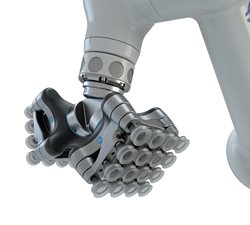 2. VG-10 Vacuum Gripper
2. VG-10 Vacuum Gripper
Unlike traditional vacuum grippers, the VG-10 includes a built-in vacuum pump, so an external air source is not required. It also comes with innovative features like dual-zone control and flexible arms that can be adjusted to handle a variety of objects.
3. Gecko Gripper
Perfect for gripping flat, porous objects like circuit boards, this gripper is electrically activated, eliminating the need for external airlines.
Robotiq – offers electrical and vacuum gripping solutions.
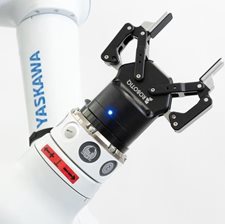 1. Hand-E Adaptive Gripper
1. Hand-E Adaptive Gripper
Rated for collaborative operation, this mechanical gripper offers a 50mm stroke.
2. 2F-85 and 2F-140
Offering longer strokes, these grippers allow a robot to pick up larger parts with varying amounts of gripping force.
Schmalz – creates modular vacuum gripping solutions for the HC10DT robot.
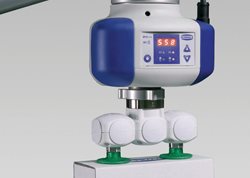 1. ECBPi
1. ECBPi
Equipped with an adjustable, internal vacuum pump so no additional airlines are required, the modular design of this gripper allows it to be modified according to the part.
2. FXCB
Designed for collaborative robots, this foam pad vacuum gripper requires an external air supply.
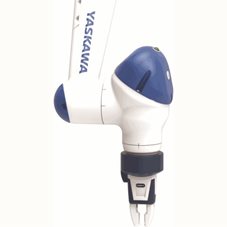
Schunk – offers a collaborative gripper option.
1. CoAct Gripper
Rated for collaborative use, this mechanical gripper includes a host of features including adjustable gripping force, open/close sensors, visual status indicator and adjustable finger inserts.
Soft Robotics – offers a modular, soft gripper solution.
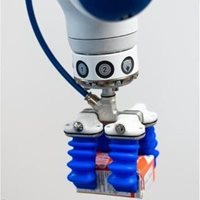 1. mGrip P4Y
1. mGrip P4Y
Pneumatically actuated, this hybrid gripper uses an external air supply to open and close a “soft” mechanical gripper. A unique design enables the gripper to grab soft or delicate items of various sizes (including food), and its modular characteristics allow it to be optimized to compliment the application.
Moving forward with gripper technology
When researching the large variety of end-of-arm tooling options available, it may also be important to consider other things like sanitation requirements, ease of use, and maintenance costs. While keeping track of these factors and nuances may seem overwhelming – especially to someone branching out into robotics – the good news is that all EOAT options from Yaskawa Motoman technology partners have been evaluated to work out of the box with Yaskawa Smart Series robots.
For more information, please visit
smart.motoman.com, or call our experts to further discuss your project needs.